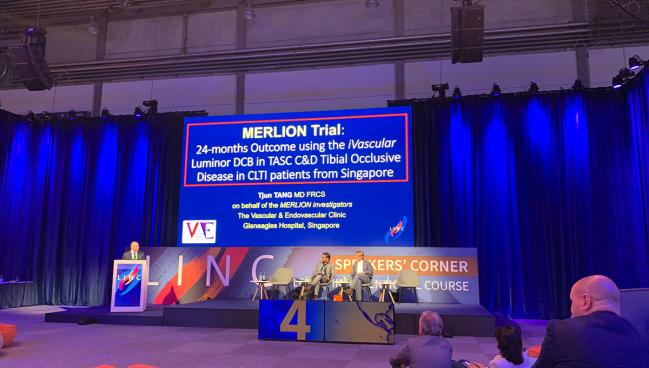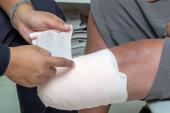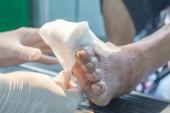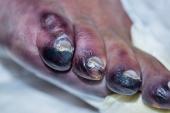What Works, What’s Noise? Novel Approaches Offer Hope in CLTI
Getting good data on wound healing and its impact on CLTI patients’ lives is an ongoing challenge, says Raghu Kolluri.

LEIPZIG, Germany—Despite advances in endovascular therapy, surgery, and medications, patients with chronic limb-threatening ischemia (CLTI) remain a challenging population at high risk for amputation and death, which researchers here showed they are battling with whatever works.
“You're definitely seeing passion for these patients where people are throwing the kitchen sink at the disease process. Honestly, that is the right thing and hopefully something will stick,” Raghu Kolluri, MD (OhioHealth Heart and Vascular, Columbus, OH), told TCTMD. “But then the issue is, how do we learn in a methodical way what works and what doesn't? How do we get a proper signal and weed out the noise? That is the difficult part in this space, in my opinion.”
Kolluri co-moderated a session here at LINC 2023 where investigators from across the globe shared their insights into unique processes for trying to stay on top of wounds and keep their advanced CLTI patients alive and feeling well.
“The BASIL-2 study and BEST-CLI show us that the mortality rate is up to 50% at 2 to 3 years. So, of the remaining time, how do we make their quality of life good? The answer to that is having those wound-free days where they're not spending every week going to the wound center,” Kolluri added.
MERLION
From Singapore, Tjun Yip Tang, MD (Gleneagles Medical Centre), presented 2-year results from the 50-patient MERLION trial in CLTI patients with TASC C and D tibial occlusive disease and high rates of diabetes, end-stage renal failure, and frailty. He noted that these patients frequently present late when options are limited.
“The diabetic foot challenge in Singapore is mounting,” Tang said, adding that the rate of major amputation there is four times those of patients in Western countries.
MERLION patients had a mean age of 66 years, and most had Rutherford class 5 CLTI with significant tissue loss to feet and toes. More than half of patients had severely calcified lesions.
For the intervention, the investigators used a high-dose paclitaxel drug-coated balloon (Luminor, iVascular) combined with bailout stenting with a DES (Angiolite, iVascular).
At 24 months, amputation-free survival was 55%, down from 74% at 12 months, Tang said. Among those who did survive to 24 months, wound healing was 83%, up from 65% at 12 months. Additionally, 85% of all survivors at 24 months had improved by one or more Rutherford category.
Umbilical Cord Jelly
From Poland, Tomasz Kwiatkowski, MD (John Paul II Hospital, Krakow), described the use of Wharton’s jelly mesenchymal stem/stromal cells to heal wounds in a small pilot study, called CIRCULATE N-O CLI, of no-option CLTI patients.
A gelatinous substance found within the umbilical cord, Wharton’s jelly is known to secrete proangiogenic factors. Because it does not contain major histocompatibility complex (MHC) class II antigens on its surface, there is no need for immunosuppression, Kwiatkowski explained. Additionally, because the cells were obtained from donated umbilical cords, there is little ethical concern about their use.
The five patients (mean age 65 years) had primarily Rutherford class 4 or 5 CLTI, with one having Rutherford class 6 and enrolled on a compassionate basis prior to a scheduled amputation. According to Kwiatkowski, patients received combined intraarterial and intramuscular doses of the Wharton’s jelly cells at 6-week intervals, with a total of three to six doses per patient. There were no procedure-related adverse events.
Grandma simply wants to wear her shoes and go dance at her granddaughter's wedding. Raghu Kolluri
At 48 months of follow-up, all patients remained alive, with one major amputation occurring in the patient with Rutherford class 6.
“All other patients at 48 months had completely healed ulcerations and were free from rest pain,” Kwiatkowski noted. Those patients all also saw a decline of one or two Rutherford classes.
“We also observed that after the second and third and especially fourth administration, the vast majority of patients had clinical signs of hyperemia in the treated limb,” he added. These included skin reddening and local temperature rise of the limb. According to Kwiatkowski, the investigators viewed these not as side effects of the therapy, but as “kind of a short-term efficacy signal” that the cells were helping to heal tissue in the limb.
As a result of this success, the investigators have received funding for a multicenter, double-blinded clinical trial to further study the impact of this therapy, including how and why it may work for some CLTI patients, Kwiatkowski added.
Angiogenic Predictors of Tissue Healing
Also from Poland, Martyna Schönborn, MD (Jagiellonian University Medical College, Krakow), showed new research supporting the role of circulating angiogenic factors in 41 CLTI patients with ischemic diabetic foot syndrome (mean age 67.3 years; 17% female). All had undergone endovascular therapy but had significant tissue loss of the feet.
Patients who had penetrating foot ulcers that were healing were found to have higher median plasma values of a proangiogenic substance called placental growth factor (PlGF), while those with nonhealing ulcers had higher rates of an antiangiogenic factor called pigment endothelium-derived factor (PEDF) in their circulating plasma.
What this means is unclear, but Schönborn said more research could help tap into how these factors are connected with better healing after a revascularization for CLTI.
To TCTMD, Kolluri said wound healing is an important endpoint that should be included in large RCTs of CLTI interventions, but usually isn’t.
“We constantly chase data points that we know how to get to, like amputation-free survival or what the device does in the artery. But are those really what our patients want? No. Grandma simply wants to wear her shoes and go dance at her granddaughter's wedding,” he said.
While the data presented here represent valiant efforts to improve the lives of patients living with CLTI, both Kolluri and co-moderator Francesco Liistro, MD (San Donato Hospital Milano, Italy), noted that a more cohesive framework of what works and what doesn’t in larger populations of patients with below-the-knee CLTI lesions is a priority. More data in this regard are expected from the ongoing LIFE-BTK trial, they added.
L.A. McKeown is a Senior Medical Journalist for TCTMD, the Section Editor of CV Team Forum, and Senior Medical…
Read Full BioSources
Schönborn A. Angiogenic factors changes after endovascular revascularisation of lower limb arteries in patients with diabetic foot syndrome. Presented at: LINC 2023. June 7, 2023. Leipzig, Germany.
Kwiatkowski T. Wharton’s jelly mesenchymal stem/stromal cells in no-option critical limb ischemia: the CIRCULATE N-O CLI pilot study. Presented at: LINC 2023. June 7, 2023. Leipzig, Germany.
Tang TY. MERLION trial: 24 months outcomes in tibial occlusive disease. Presented at: LINC 2023. June 7, 2023. Leipzig, Germany.
Disclosures
- None of the authors report relevant conflicts of interest.





Comments